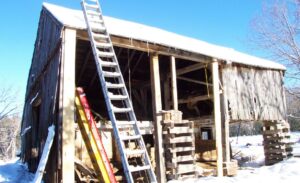 The charm and history encapsulated within the aged timbers of an old barn are irreplaceable. Wood, the backbone of these rustic structures, tells a story of times past while providing strength and character. However, wood’s natural enemy, rot, poses a significant challenge, particularly in historic barns. This degradation not only compromises the barn’s aesthetic appeal but also its structural integrity. Recognizing and addressing wood rot is critical in preserving these treasured pieces of history.
The charm and history encapsulated within the aged timbers of an old barn are irreplaceable. Wood, the backbone of these rustic structures, tells a story of times past while providing strength and character. However, wood’s natural enemy, rot, poses a significant challenge, particularly in historic barns. This degradation not only compromises the barn’s aesthetic appeal but also its structural integrity. Recognizing and addressing wood rot is critical in preserving these treasured pieces of history.
Rotted Wood on Old Barns
Wood has been a fundamental building material for barns throughout history. Its availability, versatility, and strength made it an obvious choice for early builders. However, as magnificent as these timbers are, they are susceptible to an age-old nemesis: wood rot. In historic barns, the battle against rot is crucial, not just for the structure’s integrity but also for preserving a piece of history.
The challenge of wood rot in historic barns lies in its stealthy nature; often, significant damage is done before it’s visibly detected. Understanding this threat is the first step in effective barn preservation.
What is Wood Rot?
Wood rot is essentially the decay of wood caused by fungi. These microscopic organisms feed on the cellulose and lignin in wood, weakening and eventually destroying it. The two main culprits of wood decay in barns are dry rot and wet rot.
Dry rot occurs in wood with a moisture content above 20%, but as the name suggests, the wood often appears dry. This type is particularly deceptive and destructive as the fungi can spread through structures even in areas where there is no apparent dampness.
On the other hand, wet rot occurs in timber that’s consistently exposed to moisture. It’s more localized than dry rot and usually less severe, but still a significant concern for barn owners.
Spotting the Signs of Wood Rot
Knowing the visual indicators of wood rot is critical. Look out for discolored, soft, and crumbly wood, or wood that has a sponge-like texture. Fungi often leave a telltale sign like a mushroom-like growth, a musty smell, or a damp, moldy appearance.
For a more thorough assessment, physical tests are key. Probe suspected areas with a sharp tool. If it sinks in easily, it’s a sign of rot. Regular inspections, especially in hidden areas like joints and beams, are essential in early detection.
Treating Wood Rot
When it comes to treatment, the first step is removing the affected areas. More often than not, we recommend to our clients that they replace rotted beams to ensure the structure of their barn and extends its longevity. New beams also help with ventilation, which is key to preventing moisture buildup, a primary cause of rot.
Preventative Measures
Prevention is always better than cure, especially with wood rot. Moisture control is paramount. Regular checks and maintenance of the barn can help detect early signs of damage and extend the life of your historic structure.
The ongoing battle against wood rot in historic barns requires staying out in front of potential issues and timely intervention. Understanding the nature of wood rot, spotting early signs, and taking immediate action can save these treasured structures from irreversible damage.
Remember, maintaining a historic barn is not just about preserving a structure; it’s about preserving a piece of history. If you’re facing challenges with wood rot or have concerns about the structural integrity of your historic barn, don’t hesitate to reach out to us. Colonial Restorations, LLC has the expertise and passion needed to breathe new life into your historic structures. Remember, it’s not just about fixing; it’s about preserving a legacy.

Leave a Reply